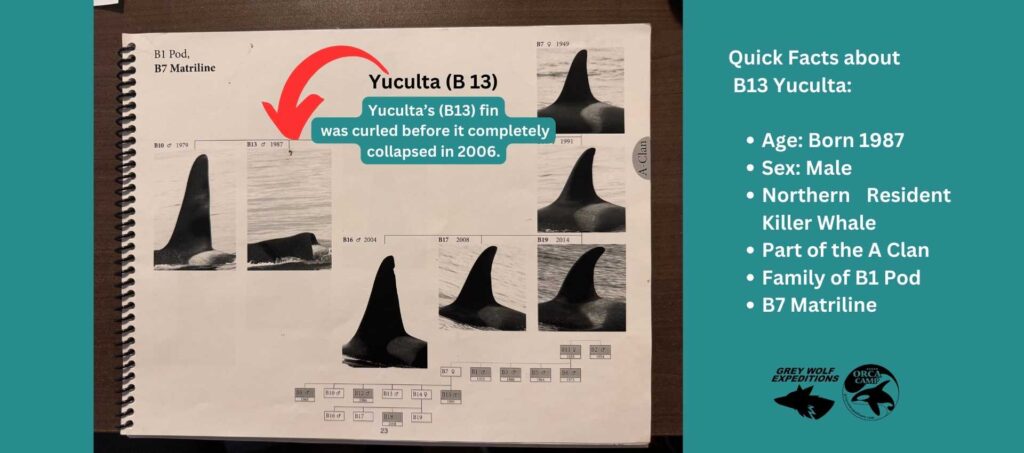Yuculta (B13) – A Wild Orca with A Flopped Fin
B13, also known as Yuculta, is a wild orca male from northern resident killer whales born in 1987.
He is part of the A Clan and B1 Pod. His matriline is known as the B7’s and includes his mother, his sister, and his sister’s calves. Yuculta, is one of the most easily identified northern residents due to his flopped over fin, which rests along his back to the left. Yuculta’s (B13) fin was curled before it completely collapsed. Suggesting that for these individuals there may be a genetic component regarding the structural integrity.
In the world of marine life, the story of Yuculta (B13), a male orca with a fully collapsed fin, has captivated researchers and enthusiasts alike. This section will delve into various aspects surrounding this intriguing creature, including his age, the reasons behind his collapsed fin, and the status of his brother.
The collapse of Yuculta’s fin has sparked curiosity among marine biologists and enthusiasts alike. While there are multiple factors that can contribute to such an occurrence, including genetic predisposition or health issues, further investigation is required to pinpoint the exact cause in Yuculta’s case.
Another question that arises is whether Yuculta’s brother is still alive. The status of his sibling holds significance in understanding potential genetic or environmental factors that may have contributed to Yuculta’s condition. Researchers continue their efforts to gather information regarding Yuculta’s family dynamics and the well-being of his brother.
By exploring these facets surrounding Yuculta (B13) – from his age and the reasons behind his collapsed fin to the status of his brother – we gain valuable insights into this unique member of the Northern resident killer whale population.
The Development of an Unusual Fin:
As a juvenile, B13’s fin, like all young Orcas, would have been small and curved. However, as male and female killer whales mature, they undergo sexual dimorphism, resulting in distinct physical differences. Male Orcas, in their early teens, begin to “sprout,” with their dorsal fins growing in size. It usually takes until their late teens for the fin to reach its full height, sometimes towering up to 1.8 meters (6 feet) tall. Females, on the other hand, retain a smaller, more curved fin throughout their lives.
B13’s Unique Journey:
B13’s fin started to show signs of curvature and ruffling during his teenage years. However, in the summer of 2006, when he was nineteen years old, his fin fully flopped over. Remarkably, even after 15 years, his fin has not regained any rigidity. Despite this unusual condition, it does not seem to impede his survival.
Understanding the Dorsal Fin:
The dorsal fin of a killer whale is composed of dense connective tissue made up of collagen fibers, without any bones. This type of tissue is susceptible to injury, and many killer whales, both male and female, bear permanent scars or wrinkling on their fins due to past injuries or aging. In fact, B13’s brother, Slingsby (B10), also has a buckled dorsal fin, making them a distinct family within the Orca community. Slingsby has not been seen in many years and is considered diseased.
Comparing Populations:
The prevalence of abnormal dorsal fins varies among different killer whale populations. According to Dr. Ingrid Visser, in the late 1990s, 23% of male killer whales in the New Zealand population had collapsed, collapsing, or bent dorsal fins. However, only one male had a fully folded fin. During the same period, the percentage in British Columbia was less than 5%, and in Norway, it was a mere 0.57%. Currently, among the killer whale populations that frequent B.C. waters, several males exhibit “hooked” dorsal fins or other significant abnormalities. However, B13 stands alone with his fully flopped fin.
Unraveling the Causes:
Numerous theories have been proposed to explain the collapse of dorsal fins in wild killer whales. These include injury, age, stress, dehydration, and poor health. Considering that B13 has survived with his flopped fin, it is likely that his condition is DNA related, or possibly an injury in his young age rather than significant stress or illness.
Examining Captive Orcas:
It is worth mentioning that the phenomenon of collapsed dorsal fins is more commonly observed in captive killer whales. The National Marine Fisheries Service (NMFS) reports that the collapse of dorsal fins in captivity is likely due to irreversible structural changes in the fin’s collagen over time. Factors such as altered water balance, reduced activity patterns leading to lowered blood pressure, and overheating of the collagen due to increased exposure to ambient air have been suggested as possible causes. The inadequate space in which captive whales swim, often confined to small circles, is also believed to contribute to dorsal fin collapse.
Conclusion:
B13, the Orca with the flopped fin, continues to captivate our attention and raise important questions about the complexities of marine life. As we strive to protect and understand these magnificent creatures, it is crucial that we remain vigilant and respect legal distances to minimize disturbance. Let us marvel at the wonders of nature and work together to preserve the beauty of our oceans for generations to come.
References:
- Personal observation since 2004 in Johnstone Strait.
- Mers Society (2023). Yes, he is an Orca.
- Birdsall, C. (2014). The case of the flopped-over fin. BC Cetaceans Sightings Network.
- Wikipedia. (n.d.). Dorsal fin collapse.
